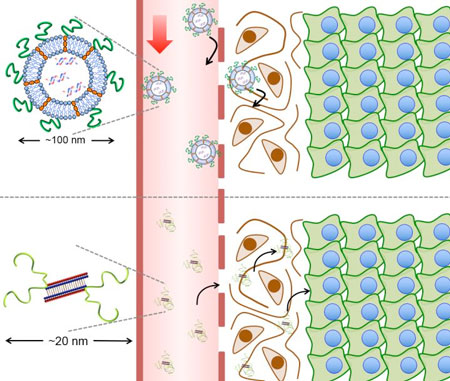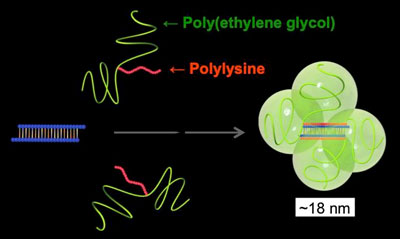| Apr 24, 2019 | |
New nanomedicine slips through the cracks(Nanowerk News) In a recent study in mice, researchers found a way to deliver specific drugs to parts of the body that are exceptionally difficult to access. Their Y-shaped block catiomer (YBC) binds with certain therapeutic materials forming a package 18 nanometers wide. The package is less than one-fifth the size of those produced in previous studies, so can pass through much smaller gaps. This allows YBCs to slip through tight barriers in cancers of the brain or pancreas. |
|
| The fight against cancer is fought on many fronts. One promising field is gene therapy, which targets genetic causes of diseases to reduce their effect. The idea is to inject a nucleic acid-based drug into the bloodstream - typically small interfering RNA (siRNA) - which binds to a specific problem-causing gene and deactivates it. However, siRNA is very fragile and needs to be protected within a nanoparticle or it breaks down before reaching its target. | |
 |
|
| Nanoparticles are typically too big to permeate some types of tissues (top). The researchers' new nanomachine is much smaller so can pass through these tissues (bottom). (Image: Kanjiro Miyata) | |
| "siRNA can switch off specific gene expressions that may cause harm. They are the next generation of biopharmaceuticals that could treat various intractable diseases, including cancer," explained Associate Professor Kanjiro Miyata of the University of Tokyo, who jointly supervised the study (Nature Communications, "In vivo rendezvous of small nucleic acid drugs with charge-matched block catiomers to target cancers"). "However, siRNA is easily eliminated from the body by enzymatic degradation or excretion. Clearly a new delivery method was called for." | |
| Presently, nanoparticles are about 100 nanometers wide, one-thousandth the thickness of paper. This is small enough to grant them access to the liver through the leaky blood vessel wall. However some cancers are harder to reach. Pancreatic cancer is surrounded by fibrous tissues and cancers in the brain by tightly connected vascular cells. In both cases the gaps available are much smaller than 100 nanometers. Miyata and colleagues created an siRNA carrier small enough to slip through these gaps in the tissues. | |
| "We used polymers to fabricate a small and stable nanomachine for the delivery of siRNA drugs to cancer tissues with a tight access barrier," said Miyata. "The shape and length of component polymers is precisely adjusted to bind to specific siRNAs, so it is configurable." | |
 |
|
| The researchers' nanomachine is just under 20 nanometers (nm), around the size of a microchip transistor. (Image: Kanjiro Miyata) | |
| The team's nanomachine is called a Y-shaped block catiomer, as two component molecules of polymeric materials are connected in a Y-shape formation. The YBC has several sites of positive charge which bind to negative charges in siRNA. The number of positive charges in YBC can be controlled to determine which kind of siRNA it binds with. When YBC and siRNA are bound, they are called a unit polyion complex (uPIC), which are under 20 nanometers in size. | |
| "The most surprising thing about our creation is that the component polymers are so simple, yet uPIC is so stable," concluded Miyata. "It has been a great but worthy challenge over many years to develop efficient delivery systems for nucleic acid drugs. It is early days, but I hope to see this research progress from mice to help treat people with hard-to-treat cancers one day." |
| Source: University of Tokyo | |
|
Subscribe to a free copy of one of our daily Nanowerk Newsletter Email Digests with a compilation of all of the day's news. |
